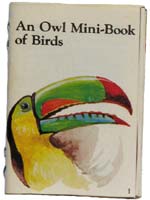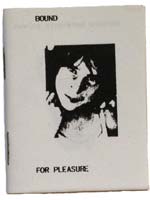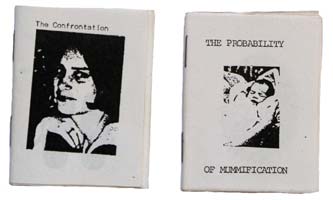The Evolution of the Mini-Book
When I was about six I had a subscription to Owl magazine. In one issue they had a page you cut out, cut up and collated into a mini-book about birds. In 32 pint-sized panels The Owl Mini-Book of Birds introduced twenty-seven orders of birds beginning with the most primitive, flightless birds, and ending with the most advanced, perching birds. I’ve moved house at least 12 times since I was six, but somehow that wee book never got lost in the shuffle. I still have it.

When I was in high school I was painting horrible abstracts in acrylics on canvas board, writing excruciating poetry and studying classical guitar. I can sight-read music, but I’m completely tone deaf so a career in music was out. It was a toss-up between writing and visual arts until, when I was fifteen going on sixteen, I spent a summer in New York studying life drawing and anatomy at the Art Student’s League. There under the tutelage of Nicki Orbach I became simultaneously addicted to drawing and anatomical drawings and decided to apply to art school. If you’ve just Googled yourself and are reading this now Nicki Orbach, know that you changed my life.
When I was seventeen I got into Concordia Fine Arts and soon after got a job at the Concordia Fine Arts Library. There I became simultaneously addicted to the disordered stacks of the now defunct Norris Library and the Fine Arts Slide Library photocopy machine. I used the hell out of that photocopy machine. I carried obscure anatomy books out the library by the armload, photocopied all the diagrams and returned the books unread. There were complaints. I almost got fired a number of times. For more on my tawdry affair with the photocopier, read: A Little Talk About Reproduction.
This was in the early nineties, I should mention, before personal computers came along and made themselves accessible. The drawing classes at Concordia were not quite on par with those at the Art Students’ League. I took a collage class with David Moore. There were photos I didn’t want to cut up. So I photocopied them. There were books I didn’t want to cut up, with anatomical diagrams in them more beautiful than anything I could draw, and there were also diagrams for all my other favourite things: botany, embroidery, analytical geometry, you name it. So I photocopied them, called them "found drawings" and found uses for them.

The first mini-book I made as an adult bore the slightly adult title, Bound For Pleasure. It was based on a poem of the same name and was illustrated with an erratum of diagrams ranging from a garter belt to a bandaged foot. The poems got better over time. The collection of found drawings grew. In art school I made four mini-books: Bound for Pleasure, The Confrontation, The Probability of Mummification, and The Basement Family Pharmacy. They’re no longer in print. Mostly I just gave them all away.

In the fall of 1993 I discovered the Internet, got a Unix shell account and set out to learn everything there was to know about computers. By the fall of 1994 I was no longer working at the Slide Library and thus no longer had illicit access to an after-hours photocopy machine. In the fall of 1995 I did a 10-week thematic residency at the Banff Centre, which was call the Banff Centre for the Arts back then. It turns out that all the big things in life happen in the fall.
The theme of the Banff residency was: Telling Stories, Telling Tales. The first story I told them was that I was a writer, which, as far as I knew, I was not, but they let me in anyway. At Banff I attempted to make a number of mid-sized mini-books using the computer, but they never went anywhere. I made this one book based on a circular story. Because it was a book, when people got to the end they just stopped, because that’s what you’re supposed to do with a book. Then the guy in the next studio over pointed out that if I made it into a web page I could link the last page to the first page so the reader could keep going around and around. So I did. My first ever electronic literature project was designed for Netscape 1.1 and it still works: Fishes & Flying Things. The guy in the next studio over was Velcrow Ripper. If you’ve just Googled yourself and are reading this now Velcrow Ripper, know that you changed my life.
I didn’t even think about making another mini-book for years. Too busy paying off my student loan. Luckily web art led to a few marketable skills. I’ve worked in every aspect of the Internet industry, as artist, designer, programmer, teacher, consultant, and even, once, a three-year stint as the manager of a multi-national web development team. I quit that job in the fall of 2001. Yes, in the fall.
After three years in the corporate world I never wanted to look at the web again. So I began writing a novel. About eight months into that as yet unfinished project I realized how long it would take. Needing to finish something immediately in order to sustain my sanity, all of a sudden I found myself making a mini-book. Not surprisingly, that book, Down the Garden Path was all about how incredibly long it takes to "make a thing which then exists and maybe it is beautiful."
I’m still working on the novel. And a collection of short stories. Or two. The post-corporate traumatic stress disorder has worn off and I’m back to making electronic literature again. Sometimes I do these things separately, more often all at once. Each new mini-book begins with a piece of writing, a short piece that I can’t get out of my head. Images accrue around it. Sometimes other texts attach themselves to my text and sometimes there are videos too. Three of the most recent mini-books are based on web projects: Entre Ville, The Cape, and How I Loved the Broken Things of Rome. The web is nice, but nothing beats cutting stuff up with scissors.
Look for these and other mini-books in DISTROBOTO machines around town. Or just ask me next time you see me – there are usually some in my purse.
. . . . .

When I was in high school I was painting horrible abstracts in acrylics on canvas board, writing excruciating poetry and studying classical guitar. I can sight-read music, but I’m completely tone deaf so a career in music was out. It was a toss-up between writing and visual arts until, when I was fifteen going on sixteen, I spent a summer in New York studying life drawing and anatomy at the Art Student’s League. There under the tutelage of Nicki Orbach I became simultaneously addicted to drawing and anatomical drawings and decided to apply to art school. If you’ve just Googled yourself and are reading this now Nicki Orbach, know that you changed my life.
When I was seventeen I got into Concordia Fine Arts and soon after got a job at the Concordia Fine Arts Library. There I became simultaneously addicted to the disordered stacks of the now defunct Norris Library and the Fine Arts Slide Library photocopy machine. I used the hell out of that photocopy machine. I carried obscure anatomy books out the library by the armload, photocopied all the diagrams and returned the books unread. There were complaints. I almost got fired a number of times. For more on my tawdry affair with the photocopier, read: A Little Talk About Reproduction.
This was in the early nineties, I should mention, before personal computers came along and made themselves accessible. The drawing classes at Concordia were not quite on par with those at the Art Students’ League. I took a collage class with David Moore. There were photos I didn’t want to cut up. So I photocopied them. There were books I didn’t want to cut up, with anatomical diagrams in them more beautiful than anything I could draw, and there were also diagrams for all my other favourite things: botany, embroidery, analytical geometry, you name it. So I photocopied them, called them "found drawings" and found uses for them.

The first mini-book I made as an adult bore the slightly adult title, Bound For Pleasure. It was based on a poem of the same name and was illustrated with an erratum of diagrams ranging from a garter belt to a bandaged foot. The poems got better over time. The collection of found drawings grew. In art school I made four mini-books: Bound for Pleasure, The Confrontation, The Probability of Mummification, and The Basement Family Pharmacy. They’re no longer in print. Mostly I just gave them all away.

In the fall of 1993 I discovered the Internet, got a Unix shell account and set out to learn everything there was to know about computers. By the fall of 1994 I was no longer working at the Slide Library and thus no longer had illicit access to an after-hours photocopy machine. In the fall of 1995 I did a 10-week thematic residency at the Banff Centre, which was call the Banff Centre for the Arts back then. It turns out that all the big things in life happen in the fall.
The theme of the Banff residency was: Telling Stories, Telling Tales. The first story I told them was that I was a writer, which, as far as I knew, I was not, but they let me in anyway. At Banff I attempted to make a number of mid-sized mini-books using the computer, but they never went anywhere. I made this one book based on a circular story. Because it was a book, when people got to the end they just stopped, because that’s what you’re supposed to do with a book. Then the guy in the next studio over pointed out that if I made it into a web page I could link the last page to the first page so the reader could keep going around and around. So I did. My first ever electronic literature project was designed for Netscape 1.1 and it still works: Fishes & Flying Things. The guy in the next studio over was Velcrow Ripper. If you’ve just Googled yourself and are reading this now Velcrow Ripper, know that you changed my life.
I didn’t even think about making another mini-book for years. Too busy paying off my student loan. Luckily web art led to a few marketable skills. I’ve worked in every aspect of the Internet industry, as artist, designer, programmer, teacher, consultant, and even, once, a three-year stint as the manager of a multi-national web development team. I quit that job in the fall of 2001. Yes, in the fall.
After three years in the corporate world I never wanted to look at the web again. So I began writing a novel. About eight months into that as yet unfinished project I realized how long it would take. Needing to finish something immediately in order to sustain my sanity, all of a sudden I found myself making a mini-book. Not surprisingly, that book, Down the Garden Path was all about how incredibly long it takes to "make a thing which then exists and maybe it is beautiful."
I’m still working on the novel. And a collection of short stories. Or two. The post-corporate traumatic stress disorder has worn off and I’m back to making electronic literature again. Sometimes I do these things separately, more often all at once. Each new mini-book begins with a piece of writing, a short piece that I can’t get out of my head. Images accrue around it. Sometimes other texts attach themselves to my text and sometimes there are videos too. Three of the most recent mini-books are based on web projects: Entre Ville, The Cape, and How I Loved the Broken Things of Rome. The web is nice, but nothing beats cutting stuff up with scissors.
Look for these and other mini-books in DISTROBOTO machines around town. Or just ask me next time you see me – there are usually some in my purse.
. . . . .
Labels: Banff, expozine, mini-books, web art, writing


2 Comments:
I bought one of your mini-books (I called it a zine in my "review" of expozine on my blog - whoopsies!) at Expozine and I like it very much - someone is going to be getting it in a long distance carepackage sometime very soon.
I like this post - I like hearing the stories behind the stories. I also like playing with scissors and am deep in the midst of experiencing my own corporate trauma - it's good to hear you got out and survived!
My cousin is this N. Orbach that you have talked about. She has also been a great inspiration in my life.
Post a Comment
<< Home